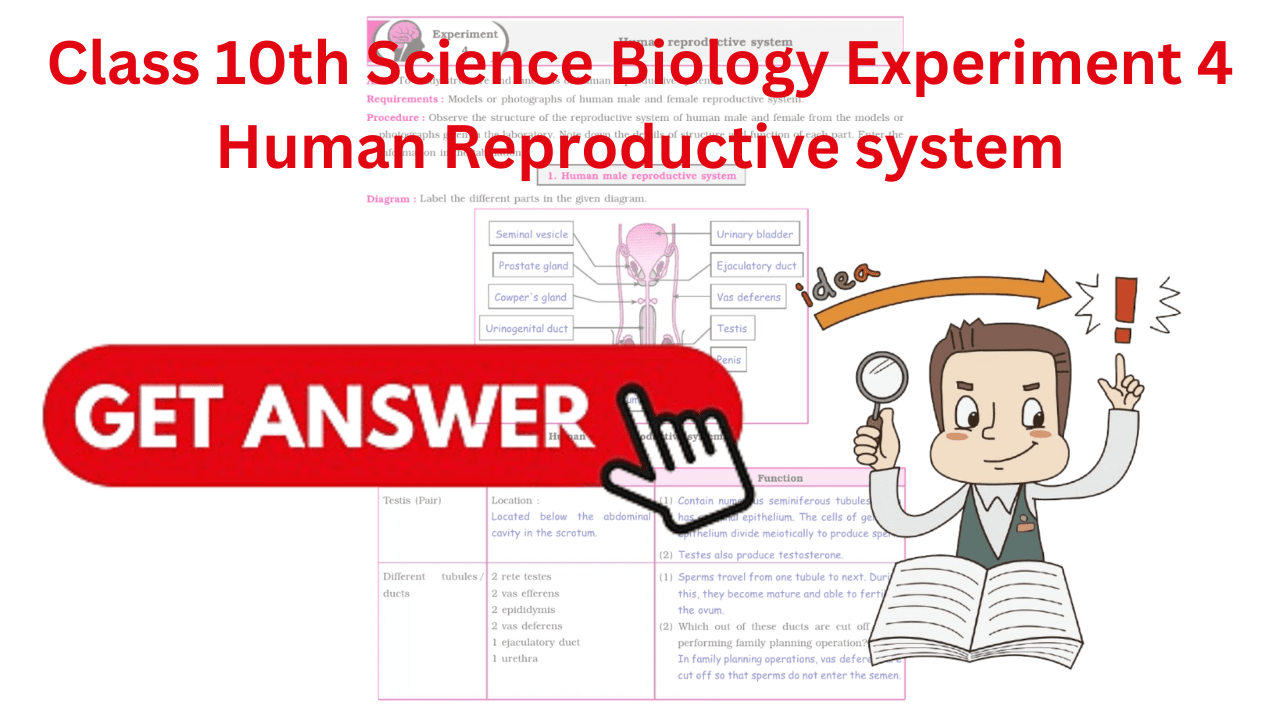Class 10th Science Biology Experiment 4 Human Reproductive system Answer Solutions.
Aim : To study structure and functions of human reproductive system.
Requirements : Models or photographs of human male and female reproductive system.
Procedure : Observe the structure of the reproductive system of human male and female from the models orphotographs given in the laboratory. Note down the details of structure and function of each part. Enter theinformation in the tabulation.
1. Human male reproductive system
Diagram : Label the different parts in the given diagram.


Observation table : Complete the given observation table.
| Organ | Structure | Function |
| Testis (Pair) | Location : Located below the abdominal cavity in the scrotum. | (1) Contain numerous seminiferous tubules. Eachhas germinal epithelium. The cells of germinal epithelium divide meiotically to produce sperm (2) Testes also produce testosterone. |
| Different tubules /ducts | 2 rete testes 2 vas efferens 2 epididymis 2 vas deferens 1 ejaculatory duct 1 urethra | (1) Sperms travel from one tubule to next. During this, they become mature and able to fertilize the ovum. (2) Which out of these ducts are cut off while per forming family planning operation? In family planning operations, vas deferens are cut off so that sperms do not enter the semen. |
| Accessory glands associated with male reproductive system. | (1) 2 seminal vesicles (2) Single prostate gland (3) 2 cowper’s glands or Bulbourethral gland | Secretions released in urethra. All secretion + sperms = semen |
| Penis (Urethra passes through Penis) | Passage of urine as well as sperms. | (1) Penis transfers the semen during intercourse. (2) Urine stored in urinary bladder is released inUrethra running through penis. |
2. Human female reproductive system
Diagram : Label the different parts in the given diagram
Observation table : Complete the given observation table.
| Organ | Structure | Function |
| 2 Ovaries | Situated in lower abdominal cavity. | Produce ova, secrete female hormones. |
| 2 Fallopian ducts(called oviducts inlower animals) | Consists of three parts. (1) Infundibulum (2) Ampulla (3) Isthmus | Transport of ovum to uterus. |
| 1 Uterus | In the middle of lower abdomen. | (1) Development of foetus (2) Birth process |
| 1 Vagina | The passage of uterus to outside. | (1) Passage for intercourse (2) Acts as birth canal (3) Passage for menstrual flow |
| Bartholin’s glands | In the vaginal wall. | For lubrication and protection of vagina. |

Inferences :
(1) The important function of human reproductive system is to produce gametes and hormones.
(2) The male hormone, testosterone is produced by testis.
(3) The two important female hormones estrogen and progesterone are produced by ovaries.
(4) The sperm and ovum are produced by meiotic division.
(5) There are 23 chromosomes each in sperm and ovum. By fertilization of these gametes zygote is formed which contains 46 chromosomes.
Multiple Choice Questions
Choose the correct alternative and write its letter (A), (B), (C), (D) in the box :
1. Which gland in human male reproductive system is single?
(A) Testis (B) Prostate gland (C) Epididymis (D) Cowper’s gland
Answer: B
2. Which sugar is present in the semen?
(A) Fructose (B) Glucose (C) Maltose (D) Lactose
Answer: A
3. Which sex chromosomal combination in the zygote is responsible for the formation of testes?
(A) XX (B) XO (C) XXY (D) XY
Answer: D
4. Which part of the human female reproductive system is under the direct control of pituitaryhormones?
(A) Uterus (B) Vagina (C) Ovary (D) Fallopian ducts
Answer: C
5. Why does women get menopause, but man does not have such stage?
(A) Female hormones stop working in 45+ age, but male hormones’ secretion do not cease. (B) Females are weak, and males are strong.(C) Females cannot sustain the pregnancy in late age and hence they get menopause. Maleshave no such problem.(D) Males have better food and exercise, female do not get such facilities.
Answer: A
6. Which part of female reproductive system that provides the space for fertilization of the egg ?
(A) Uterus (B) Fallopian ducts (C) Vagina (D) Ovary
Answer: B
7. Which group of hormones are essential for a female to become a mother?
(A) Testosterone, estrogen and progesterone (B) Estrogen and progesterone (C) FSH, LH, LTH, estrogen and progesterone (D) ICSH, LH and FSH
Answer: C
